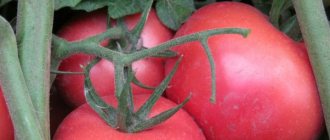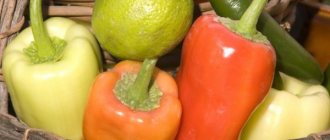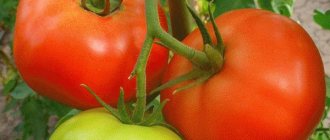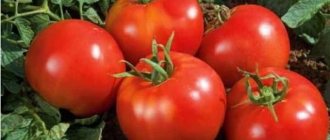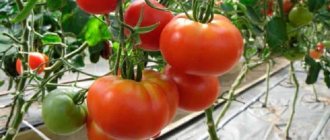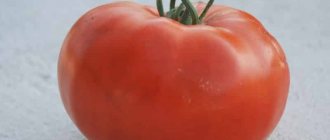Characteristics and description of tomato
The hybrid was bred by Japanese breeders from the Sakata company. Recommended for breeding under film cover. Entered into the State Register of the Russian Federation in 2009.
Reference ! The Japanese company Sakata has been breeding for more than 100 years, since 1913. It has more than 10 of its own stations and research laboratories on 5 continents of the world.
Distinctive features
The type is indeterminate, grows more than 2 m, since the growth of the main stem is not limited. The root system is compact, which allows you to plant up to 5 plants per 1 m2. The foliage is dense, the stem is powerful. On each bush, 8–10 fruiting clusters are formed, which set 5–7 fruits.
The tomato is resistant to a number of diseases: verticillium, fusarium, tobacco mosaic virus and root nematode.
Reference ! Nematodes are representatives of a large group of roundworms that parasitize animals and plants. In a short period of time they can destroy all plantings.
Ripening time is average: the first fruits are harvested 100–110 days after sowing the seeds. Ovaries are formed in any weather conditions.
Productivity is high: up to 15 kg of fruits are collected from 1 m2.
Without additional support, the stem will not support the weight of heavy fruit-bearing branches, so staking of plants is necessary. Also, seedlings need pinching and shaping.
Fruit characteristics
Ripe vegetables are round, bright red, average weight ranges from 140 to 220 g. There are 3-4 seed chambers. The pulp is dense, which complicates the preparation of freshly squeezed and canned juices.
The taste is sweet, sugary, pronounced. The peel is dense, so the vegetables are stored for a long time and retain their presentation when transported over long distances. For these reasons, the crop is bred on an industrial scale.
The use of tomatoes is universal: they are not only ideal for preparing fresh dishes, but also do not lose their taste in winter preparations. The size of the fruits allows them to be preserved whole.
The photo shows Michelle f1 tomatoes.
Characteristics
Those who grew this hybrid variety noted among its advantages:
- high productivity;
- varietal and commercial qualities of fruits;
- taste qualities;
- resistance to diseases and pests.
As a conditional disadvantage, increased requirements for the application of fertilizers and irrigation regimes are noted.
Among the features of the variety for which consumers love it, they particularly highlight its high resistance to pests and diseases. They also note the stable yield and high shelf life of the harvested crop.
Ripe fruits are bright red in color and round in shape. The tomatoes are not very large, weighing 140-220 grams . Number of chambers 3-4, dry matter content up to 6%. The harvested crop can be stored for a long time and tolerates transportation well over long distances.
You can compare the weight of the fruits of this variety with others in the table below:
| Variety name | Fruit weight |
| Michelle | 140-220 grams |
| King of Beauty | 280-320 grams |
| Pink honey | 600-800 grams |
| Honey saved | 200-600 grams |
| King of Siberia | 400-700 grams |
| Petrusha the gardener | 180-200 grams |
| Banana orange | 100g |
| Banana legs | 60-110 grams |
| Striped chocolate | 500-1000 grams |
| Big Mama | 200-400 grams |
| Ultra early maturing f1 | 100g |
Ripe fruits are excellent fresh, but are well suited for homemade preparations. Juices and pastes from tomatoes of this type are usually not made due to their low juiciness. Too many tomatoes will have to be used to get an acceptable amount of juice or paste.
How to grow seedlings
Before you start sowing seeds, you need to prepare the container, soil and planting material itself. Preparation mainly consists of disinfection, as this determines the healthy growth of the seedlings.
Seed preparation
The seed fund of hybrid crops does not retain genetic memory, so it makes no sense to collect grains for planting yourself: the grown fruits will noticeably deviate from the declared qualities. Therefore, you will have to buy material every time.
Purchased seeds are pre-treated, so disinfection is not required. However, to strengthen the immune system, grains can be kept for 20 minutes in a weak solution of potassium permanganate, and then left for 10 hours in a growth stimulator. This increases the germination rate. Stimulants used include Epin and Kornevin.
Container and soil
The soil for sowing is prepared universally: from garden soil, peat and humus. For looseness, add a little river sand. To saturate the soil with useful substances, add wood ash. It also reduces acidity, which has a beneficial effect on the growth of any tomato crop.
After mixing all the components, the resulting mixture is poured with a hot, strong solution of manganese. Soil disinfection is carried out to destroy pathogenic flora.
The containers, like the soil, are treated with a strong solution of manganese, especially if these containers have already been used for planting: surviving pathogenic spores can cause great damage to the seedlings.
Drainage holes are made at the bottom of each container to drain excess moisture. In the absence of drainage, excess liquid will have a detrimental effect on young roots.
You can plant in a common wooden box and in individual plastic or peat cups.
Sowing
The seeds are buried 1.5–2 cm with a distance between grooves of 3 cm. The temperature in the room where the containers will be located must be at least +22 °C. After sowing, the soil is moistened with warm, settled water and covered with film. When creating a greenhouse effect, grains will germinate faster.
Until the seedlings emerge, the containers are left in a bright room.
Seedling care
After the shoots emerge, the film is removed and the containers are placed on the windowsill. It is important to provide the seedlings with 16-hour lighting. If there is a shortage of it, the seedlings will stretch out and weaken. To prevent this, additional lamps are installed.
Water as the top layer of soil dries with warm, settled water from a shallow watering can. After this, the soil is loosened superficially: with deep loosening, there is a high probability of disturbing the root system.
When 2 true leaves appear, a pick is carried out, planting the seedlings in separate cups. This allows plants to develop more intensively due to the growth of lateral roots.
If growth is poor, a week after picking, the seedlings are fed with liquid seedling fertilizer. The same fertilizing is carried out before planting in the ground.
Seedlings must be hardened off 10 days before planting in the ground. To do this, take it out into the open air for 1 hour during the day. Gradually, the time spent on the street is increased to 9 hours.
Recommendations for cultivation
The plant, like most members of the family, prefers the seedling method of planting. A number of simple rules will help you grow healthy tomato seedlings:
- Sowing seeds to a depth of 1.5-2 centimeters;
- Maintaining the room temperature not lower than +22 degrees;
- Using universal soil for tomatoes;
- Before the sprouts appear, cover the planting with film;
- After germination, transplant the seedlings into separate pots;
- Provide seedlings with 16 hours of daylight;
- Regular watering with water at room temperature;
- Harden off 7-10 days before planting.
See also
Description of the tomato variety Bouquet of Siberia, its characteristics and productivityRead
IMPORTANT! To get the best harvest, you need to form the plant into 1 stem.
It is not recommended to place more than 5 tomato bushes on 1 square meter of land. The variety responds positively to abundant watering and fertilizers containing calcium, phosphorus and nitrogen. Mandatory care measures include:
- Feed up to 6 times during the summer;
- Watering with warm water in the evening or morning;
- Loosening the soil;
- Weeding;
- Tying with synthetic materials;
- Installation of supports.
How to grow tomatoes
Before planting seedlings in the soil, they dig it up and add a full range of minerals.
Landing
The compact root system makes it possible to plant up to 5 seedlings per 1 m2. A little sawdust or ash is placed in each hole 15 cm deep, which is filled with warm water.
The transplant is done on a cloudy day or in the evening. The seedlings are buried down to the first leaves, the soil is compacted and irrigated with warm water. While young bushes get used to new conditions, the soil is not moistened for a week.
Further care for tomato Michelle
The hybrid is demanding on watering and fertilizing. These are necessary conditions for its full development.
Water abundantly as the top soil layer dries out. However, there is no need to flood the seedlings: excess moisture may cause the roots to rot. To prevent the beds from drying out longer, they are mulched with peat or straw.
Loosening after watering ensures soil breathability. Oxygen supplied to the roots strengthens the plant's immunity.
Weeds take a lot of nutrients from the soil that are necessary for the growth of seedlings, so weeding is mandatory. In addition, fungal spores and many pests that are dangerous to crops of the nightshade family multiply in weeds, so proximity to weeds is extremely undesirable.
A full range of minerals is added from fertilizers. After transplantation, a fertilizer with a predominant nitrogen content is used; during flowering, phosphorus is added instead of nitrogen, and potassium substances are added at the time of fruiting.
Feed the crop once every 2 weeks. All fertilizing is combined with watering.
Features of care and possible difficulties
Without a garter, the stem will not withstand the weight of the fruit-bearing branches. Therefore, supports are installed next to each seedling, to which the stem and branches are fixed. A garter on a trellis is also possible. Between the supports installed on different sides of the bed, a wire is stretched horizontally, to which the plants are tied with synthetic material.
To get maximum benefit, it is recommended to form a bush with 1 stem. All other stepsons are removed once every 10 days. To avoid crowding of plantings, remove all lower leaves.
Peeling is carried out early in the morning so that by the evening all the wounds have time to heal. The cut areas are sprinkled with ash, ensuring disinfection.
Diseases and pests
The hybrid's genes contain good disease resistance, making it immune to many infections. However, we should not forget about prevention and increasing the immunity of seedlings.
With moderate watering, regular loosening, weeding and timely application of fertilizers, not only full development occurs, but also the strengthening of protective forces.
Before planting, the soil is spilled with a hot solution of manganese and treated with copper sulfate, thereby destroying fungal spores. This is especially important when growing tomatoes in a greenhouse.
If crops from the nightshade family grow next to tomatoes, it is necessary to regularly spray all plants with fungicidal agents. The drug “Fitosporin” has an effective preventive effect.
Dangerous pests include butterflies (more precisely, their caterpillars), whiteflies and cutworms. To combat whiteflies, use the drug “Confidor” or folk remedies (for example, planting basil, calendula and marigolds next to tomatoes). Herbs with their smell repel pests from the beds.
The smell of calendula repels not only whiteflies, but also cutworms. You can also spray the plants with a decoction of onion peels. Among the chemical preparations used are “Karate” or “Decis”.
Reference ! The cutworm is omnivorous. It destroys not only tomatoes, but also cabbage, beets, peppers and eggplants.
The nuances of growing in open ground and greenhouses
The crop is recommended for cultivation under film cover, but residents of the southern regions successfully grow it in open ground. In more severe weather conditions, tomatoes grow in heated greenhouses. Regardless of external factors, taste properties and quantitative indicators are maintained at the proper level.
To limit the growth of the main stem, pinch the crown of the plants. After this, all the energy of the bush is spent on the formation of fruits, and not on further growth.
Closed structures must be ventilated daily. This maintains humidity and temperature within normal limits, which prevents the development of fungal diseases. In addition, fresh air destroys the usual habitat of the main greenhouse pest - spider mites.
How to grow the Michel variety
Since the bushes grow more than 2 meters, and a lot of fruits are tied on the branches, the stems must be tied up. It is best to attach the bushes to the ceiling structures of a greenhouse or greenhouse. The Michel tomato needs fertilizer very much and responds very well to it. Fertilizing is done with potassium, phosphorus and nitrogen fertilizers.
On open ground, the hybrid feels good in the southern regions, although the variety is considered a greenhouse variety. In the central and northern regions of the country, tomatoes are grown exclusively in heated greenhouses.
Harvesting and application
Vegetables will ripen in the middle of the summer season. They are not allowed to overripe. A harvest harvested on time retains its marketable appearance for a long time, and the bush is unloaded for the development of the next tomatoes.
They transport ripe vegetables over any distance without losing their appearance or taste.
In cooking, the fruits of the hybrid have found universal use. They are used for all kinds of fresh dishes and for winter preparations. Smooth, brightly colored tomatoes look great in glass jars for whole-fruit canning.
General information
Tomatoes are suitable for cultivation in different climatic conditions. The originator recommends the variety for growing in film shelters. Description and characteristics of tomato:
- Early ripening, the berries are ready for picking 100 -110 days from planting;
- Stable yield, up to 4 kilograms of fruit per bush;
- The bush reaches 2 meters in height;
- Up to 7 fruits are formed in one brush;
- Indeterminate;
- Standard;
- Powerful stem;
- Good foliage;
- Resistance to many nightshade diseases;
- Handles transportation;
- Good keeping quality.
The plant shows good results in the southern regions of Russia and in temperate climates. General information about fruits:
Trending Pilaf with chicken and shrimp
- Aligned;
- Round-flat shape;
- Large, the weight of one tomato reaches 220 grams;
- Medium density;
- Red color, in finished condition;
- Number of cameras – 3-4;
- Contains up to 6% dry matter;
- Not watery;
- Juicy;
- Fragrant;
- Sugar taste.
The fruits can be used in various ways. They are suitable for canning and preparing food for the winter. The berries are processed into tomato products: paste, sauce, juice. Fresh tomato variety Michel f1 is a good component of vegetable salads.
Advantages and disadvantages of a hybrid
Due to its many positive qualities, tomato is highly valued among gardeners. It has:
- unpretentiousness to climatic factors;
- formation of ovaries in any weather;
- simple agricultural technology;
- high fruiting rate;
- resistance to many diseases;
- excellent taste;
- presentation;
- long-term storage and transportation capabilities;
- universal application.
Disadvantages include the need for pinching and staking of plants. Here you can add the purchase of seeds for each planting.
Farmer reviews
Numerous reviews speak of the trustworthiness of the culture. For most farmers, Michelle f1 brings significant profits:
Veronica, Tambov : “The hybrid bears fruit superbly. Tomatoes are juicy, aromatic and sweet. Good in salads and preserves, but not juicy enough for tomato juice. I especially liked the fact that the seedlings do not get sick at all, although they require regular feeding and watering. I can’t say that care is difficult, rather the opposite. Therefore, I recommend everyone to try it."
Evgeniy, Saratov: “Before I found my favorite taste, I tried many varieties. I like tomatoes for their high yield and easy care. I plant in large quantities, some of which are sold. Winter vegetable preparations are excellent, very tasty and last a long time, just like fresh tomatoes.”
